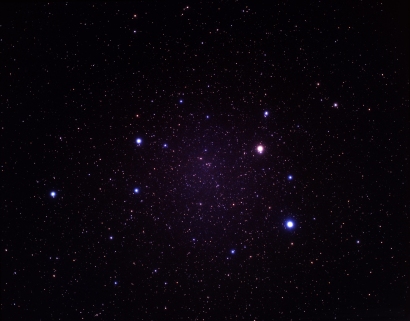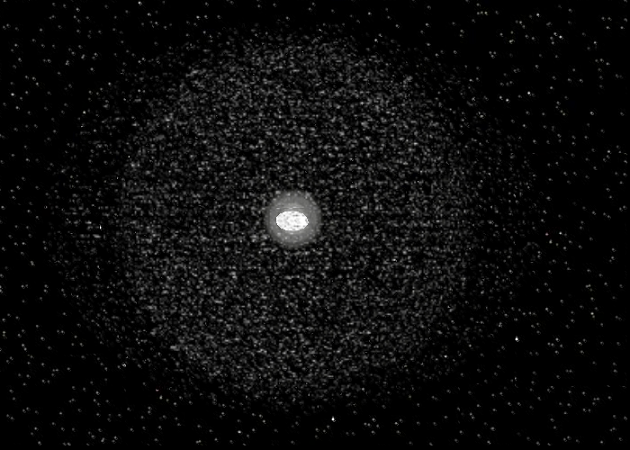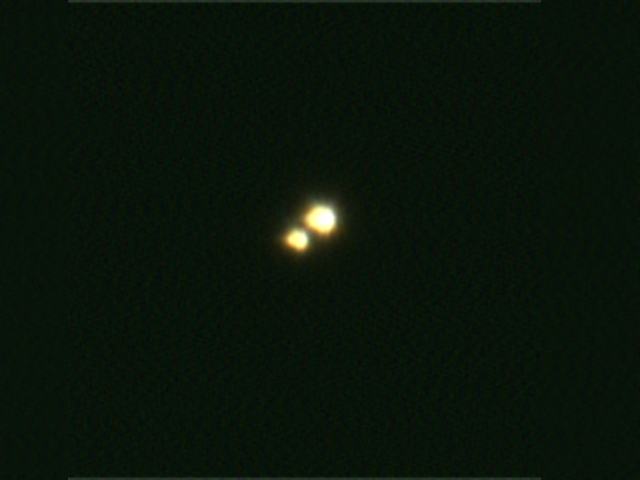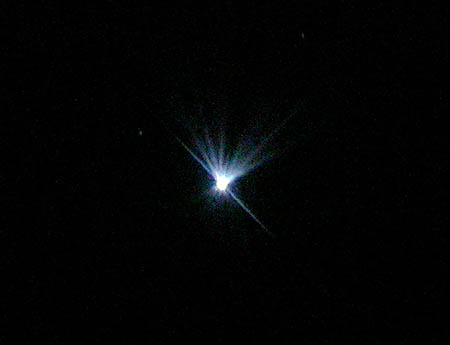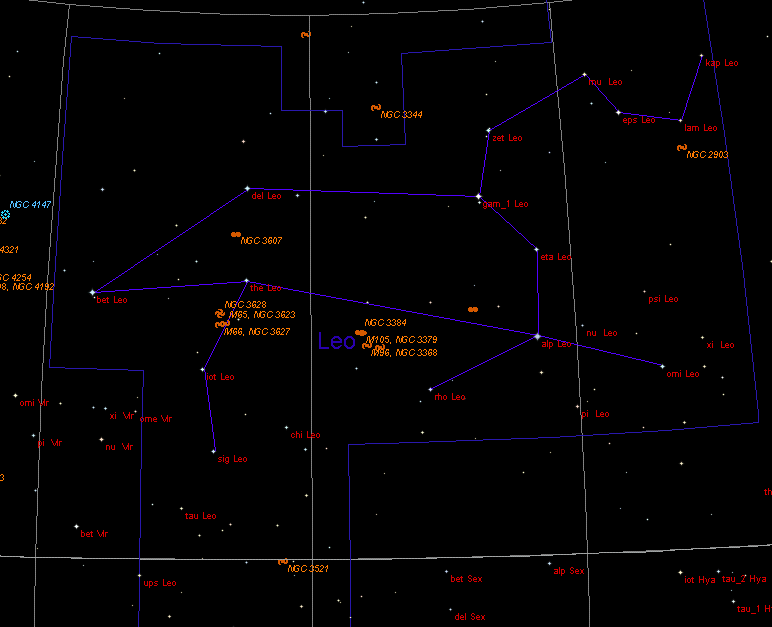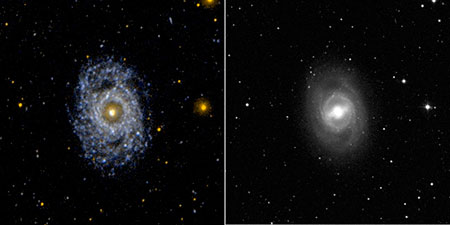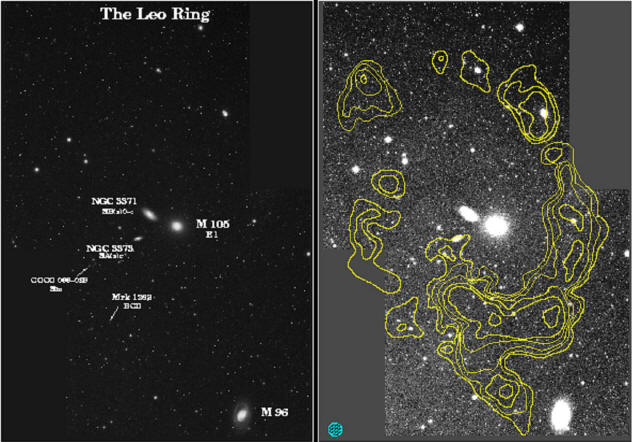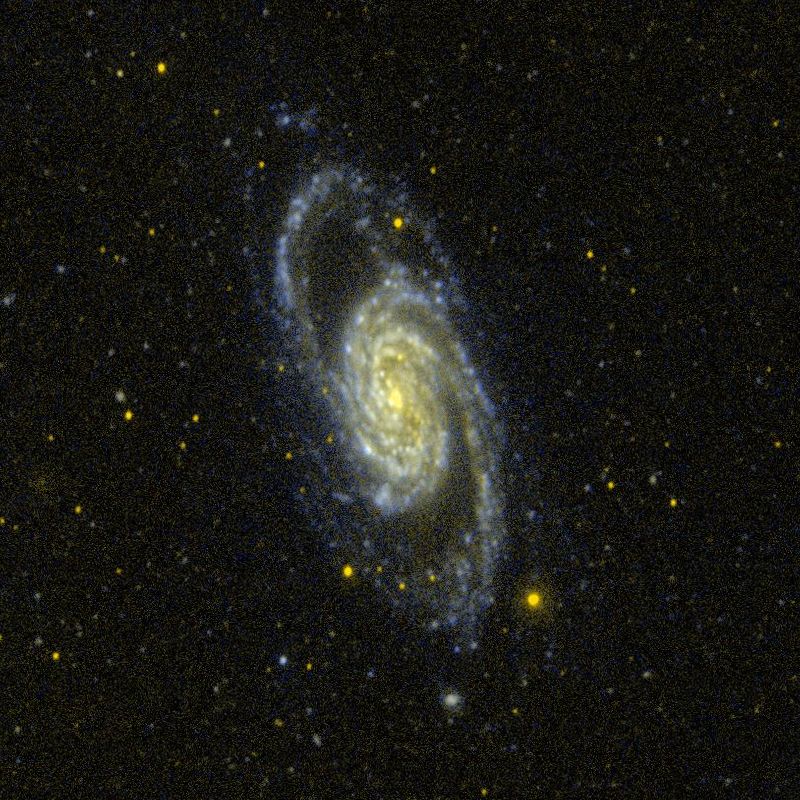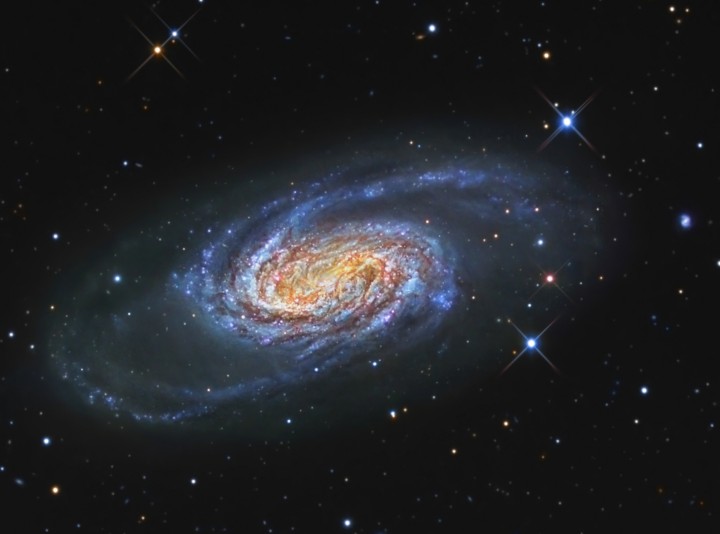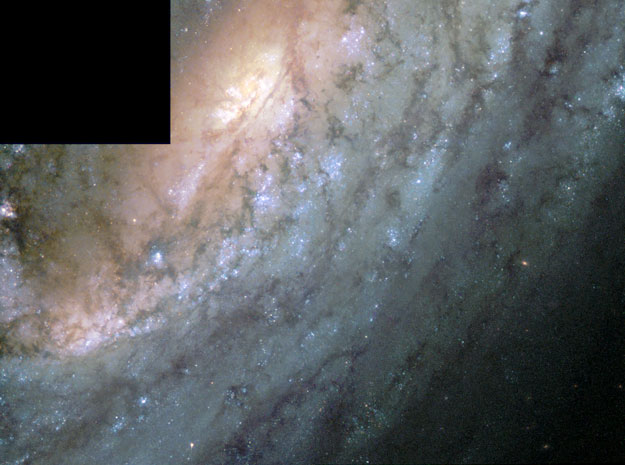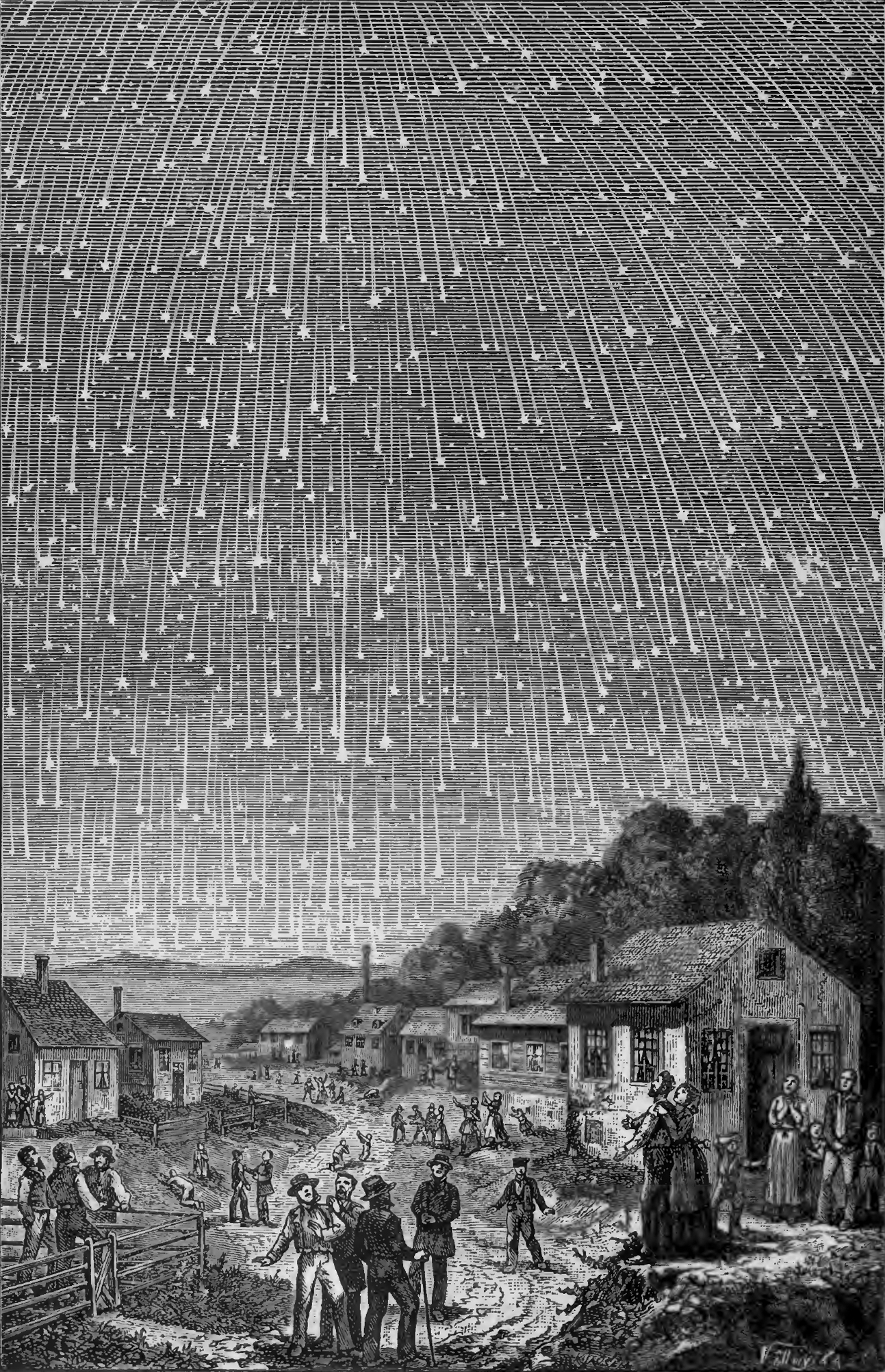What does Leo look like?
Like Gemini, most people have heard of the constellation of
Leo, because it is one of the zodiac horoscope signs (meaning that, as the Earth orbits around the Sun, the Sun sits in front of Leo for a while ie Leo is behind the sun during the daytime and so you can't see it (from about July 23rd to August 22nd). So we can see Leo best in the spring months (March to May) in the northern hemisphere, when it's pretty much visible throughout the night.
Leo is, of course, a lion. He is usually depicted as full-maned lion facing to the right, with a kind of backward facing question mark
? (often called
The Sickle) as the head and front right paw. Here are some images I found on the Internet (for once pretty much very similar):
 |
| montage of Leo constellation |
Here's a close-up of one of those images, so you can see where the stars are within the lion's body:
There are quite a few very luminous stars in Leo, which makes it a very recognisable constellation. Here's a pic with just the constellation lines drawn in:
And here's the stars without the constellation lines ( take a look at
David Malin's website, which marks the constellation lines over the stars in
a great hover-over image of Leo ):
Remember I said the front part of the constellation was called The Sickle? Well, this is a close-up of that asterism:
And the names of stars in The Sickle are Adhafera, Rasalas, Algieba, Ras Elased, Al Jabhah and the alpha star, Regulus:
Where can we find Leo?
We used the bright
Pointer stars of
the Plough (the two stars -
Dubhe and
Merak - at the front end of the saucepan shape) to find
Polaris, the
North Star. Now we can use the same two stars, but in the other direction, to find Leo:
Showing both
The Plough (from
Ursa Major) and
Polaris (in
Ursa Minor) with Leo:
Alternatively, I found this very useful map of the constellations around
The Plough on
Astronomy Trek, showing the other side of the saucepan bowl being used to find
Regulus,
Leo's alpha star over on the right of the image (hopefully it isn't too confusing):
What are the main stars in Leo?
There are a heck of a lot of really good, recognisable stars in Leo, so this bit's going to be quite long, and because there are so many, I'll show where each one is individually. Let's start with the Alpha star,
Regulus:
Regulus
The bright yellow star marks the position of Regulus at the bottom of the backward question mark:
Regulus (meaning 'Prince' or 'Little King' in Latin) is actually not a single star, but a star system of four stars. The main star,
Regulus A, is a blue-white hydrogen burning star, which has a binary (gravitationally bound) companion of about a third the mass of the Sun, that hasn't yet been observed and so hasn't got an official name. Slightly further away from this pair is another pair of
Regulus B and
Regulus C.
Regulus A is a hot, bright fast-spinning star with a radius of about three times our sun, four times the mass and about 290 times as luminous:
This is how Regulus A compares in size to the Sun:
Out of the second binary pair,
Regulus B is the more visible, and bright enough to be seen by a standard telescope, whilst its orbiting partner,
Regulus C, is barely visible, and would need a much larger telescope to capture it. These too are about 100 AU (1 AU is the distance from Earth to the Sun) apart, and they take 2000 years to orbit each other. This binary couple are just visible through an amateur telescope as a separate entity from
Regulus A.
Regulus, the star system, lies on the ecliptic (the path the sun appears to take against the background stars as we (on Earth) orbit around it, so it also has the sun, moon and planets crossing in front of it (it is 'occulted' by them)...most often by the moon.
Denebola
Although the beta star of Leo (another Blue-white, fast rotating star)
Denebola (β Leo) is actually the third brightest star varying in brightness over a period of several hours, and marks Leo's tail, and is one of three of a triangle of stars at the rear of the lion:
Denebola (a shortening of
Deneb Alased and meaning 'the lion's tail') is spinning so fast it's poles are flattened (it is what's called 'oblate' instead of spherical) and has a disc of dust/debris around it as in this pic:
Algieba
The third-named star, but second most luminous, is
Algieba (or
Al Gieba, γ Leo), which means 'forehead', actually sits on Leo's shoulder:
As is so common, Algieba is a binary, which can be distinguished (or 'resolved') as two separate stars when our atmosphere is still (and the stars aren't twinkling very much):
(There's third star that looks like it's part of the system but isn't. It just happens to lie in the line-of-sight.)
One of the two stars is a giant of
23 times the diameter and 180 times more luminous than the Sun, orbited by a planet about twice the size of the Sun (artistic drawing from
Wikipedia):
...and the other is a giant of ten times the diameter and fifty times more luminous. They are about twice the distance of the edge of the solar system from the Sun (ie, the diameter of the solar system apart) and it takes 500 years for them to complete a single orbit around each other.
Zosma
Zosma (and some variations: Zozma, Zozca, Zosca, Zubra, meaning 'girdle'; also
Duhr or Dhur -
δ Leo) is on the hip of the lion, the top of the triangle at the back. It's about double the size of the sun, though fifteen times as luminous. It's another fast-rotating (180km), 'oblate' (flat-poled sphere) hot, blue-white main sequence (hydrogen burning) star:
I'm not sure how accurate this image is, but this is the only one I could find of this star:
Ras Elased Australis
Ras Elased Australis (
ε Leo, also sometimes called
Algenubi or
Al Jabhah) is the 'Southern star of the lion's head', according to
Wikipedia. It's the one marking the tip of the backward
? or
The Sickle:
Even though it is listed as the fifth most luminous star in Leo (and actually, that is quite accurate, its apparent luminosity does place it fifth), because it is actually nearly 250 ly away; if it were as close as the above stars - the furthest of which is Algeiba at 126 ly - it would be way, way more luminous at nearly
290 times that of our Sun!
Adhafera
Adhafera (Zeta Leo) is a white giant star that is actually another multiple-star system, and it can be found in the Lion's mane:
The star system actually orbits the centre of the Milky way at a slightly skewiff angle, and this is bringing it closer to the Sun than its current 265 ly, so that it will be only 95 ly years away in about three and a half million years. If you pop over to
Ashland Astromy Studio, half way down the page there's an image that shows how the Sun's path is coming closer to Adhafera's path.
In this image, Adhafera is just above and to the left of centre. Its white colour can be seen. The author points out that what's interesting about this pic isn't Adhafera itself, but the star towards the top left corner, which should be the same white as Adhafera, but actually shows 'chromatic abberation'...it's colour is wrong!
Closer up, you can see there's more than one star in that apparent single point:
Chort
Though
Chort (or
Chertan - θ Leo) is part of the lion's hip, in Arabic it's name actually means in "ribs", so either the image has been altered, but maintains the original names, or perhaps the stars have slipped? I don't know. But, actually, there's an older alternative Latin name for it, which actually does mean 'hip' and that is
Coxa.
You can see this white dwarf star with the naked eye and, atypically (in the many star systems we've already come across) this one is alone, no binary companion. What is unusual about this star is that it is spinning at an unusually slow speed, so that heavy metals have diffused into the atmosphere...the spectrum of this star has a lot of such elements such as iron, strontium and barium (which are several times what one might expect), but very little of the lighter elements such as scandium and calcium. Professor of Astronomy, Jim Kaler, writes more about it
here.
Al Minliar al Asad
Al Minliar al Asad (k Leo) is a double star that marks the lion's nose. Derived from the Arabic for muzzle, it was originally called "
Minkhir al-Asad". In this image, that it is on the nose isn't very clear:
...but it's much clearer on this older constellation map.
Al Minliar al Asad (often just called
Kappa Leo) is smack on the lion's nose:
There are actually three stars making up Kappa Leo...The main star, Kappa Leo A, and two companion stars, Kappa Leo B and C.
Kappa Leo is an orange star with a surface temperature of about 4300 degrees, but the luminosity of more than 75 time that of the Sun, just over 200 light years away. Where some of the other stars in Leo are rotating extremely fast, this one is rotating so, so slowly, taking more than one of our Earth years (about 400 days) to turn just once.
Kappa B is the next luminous, a dwarf star, still burning hydrogen, with Kappa C being the least luminous. In fact, Kappa B was, for a long time, considered a variable star before it was recognised there was another star involved causing the brightening and dimming of the star. Kappa B takes about a thousand years to orbit Kappa A, it is so far away (150 AU)
Alterf
Alterf (λ Leo), often taken as meaning 'the view' or 'the glance' of the lion, maybe because the star was originally located on the lion's eye, another meaning of it (as interpreted for the star with the same name in the Cancer constellation) might be 'extremity', or 'tip'. Nowadays, this orange giant marks the mouth of the lion.
Ras Elased Borealis
Ras Elased Borealis (Mu Leo) lies 124 ly away and is, like
Adhafera above, is moving around the Milky Way on such a path that its path is very slowly moving closer to that of our Sun, so it will eventually be much closer than it is now, before moving away. It is an orange giant that has finished burning hydrogen and helium in the core, and has collapsed in on itself before expanding rapidly out to become the giant it is today. Now it will puff off its outer layers as it begins to cool down, perhaps to form a ring of gas around it (what's called a '
planetary nebula')
Subra
Subra (Omicron (o) Leo) is on Leo's knee. It's a white (hot) hydrogen-burning star, or rather binary star, that once, seven hundred thousand years ago, was closer relative to our Sun, and brighter, than it is now.
How far away are the main stars in Leo?
Here's my diagram to show how far away the main stars are in Leo. Except for Eta Leo (Al Jabhah) which is too far to fit into the same scale as the other stars (at 2000 ly), the rest of of the stars are all within a few hundred light years:
 |
| Distance of main stars in Leo |
What deep-sky objects are in Leo?
There are many good deep-sky objects in Leo...but two special areas of interest, rich in galaxies, are found in a couple of related groups bundled together (in orange in the image below) beneath the Lion's belly:
As well as these two main groups of deep-sky objects in Leo - the
Leo Triplet, 35 million light years away, and a second triplet (
The M96 Group) - I'll look at a couple of other Messier objects objects catalogued by
Charles Messier in 1771:
 |
| Some deep-sky objects in Leo |
The Leo Triplet
The
Leo Triplet (containing three spiral galaxies:
M65, M66 and
NGC 3628) lies between
Chort (Theta Leo) at the lion's hip and
Iota Leo at his rear leg joint, circled on the left in this image:
Here's a close-up of three Messier galaxies in the Leo Triplet:
A little bit about three galaxies in this triplet:
Messier 65 (M65, NGC 3623)
This wonderful image of M65 taken by
Wendelstein Observatory shows the spiral galaxy in all its glory. You can clearly see the dark, light-absorbing dust lanes spiralling around the core in long arms:
Messier 66 (also called M66, NGC 3627)
M66 is a beautiful spiral galaxy 95,000 light years across and about 36 million light years away. It has recently interacted with another spiral galaxy NGC 3628, which has caused it to be distorted and given it a high concentration of matter in the centre, and removed some matter from at least one of the long dust-lane arms.
NGC 3628 (Sarah's Galaxy)
The most interesting things about this galaxy, apart from that it has interacted with M66 (above), is that it is side-ways on (so we are looking at it along its galactic plane, like looking at the edge of a plate); and that it has a particularly long
tidal tail, into which galactic matter is ejected, and where increased amount of star formation takes place. Because it is edge-on, we can clearly see the dust that surrounds the galaxy blocking the starlight from the millions of stars and glowing inter-stellar gas in the centre:
Huge-LQG
Beginning relatively near (visually) to the Leo Triplet, and stretching way up above the lion's back is an unusual feature that has caused controversy in the astronomy field. It has a suitably extravagant name for the importance it's taken on: The
Huge Large [yes really!] Quasar Group (or the
Huge-LQG for short), a controversial (some consider unconfirmed) giant structure of 73
quasars (distant, high-energy galaxies with a black hole at the centre; marked with crosses in the image below), in an area of space 4 billion light-years deep. Astronomers
can't decide whether it's real group of quasars or not, or whether it simply appears so.
So you can more clearly see where this is in Leo:
Why this Huge-LQG is so controversial and important is because, if it truly exists in this form (and there are those that don't think it does) then it will go against one of the basic principals that much of astronomy is based upon, the Cosmological Principle, which says that we don't live in any special place in the Universe, and that everywhere in the Universe is pretty much the same (homogeneous). If this giant structure is real, it would imply that this homogeneity isn't true and would cause scientists to have to re-think the Cosmological Principle.
M96 group
At about the same distance (30 - 36 million light years away), and related to the Leo Triplet group,
the M96 group of galaxies consists of three Messier objects (catalogued by Charles Messier):
M96,
M95,
M105 as well as between 5 and 19 more galaxies (sometimes astronomers can be so imprecise!) that aren't so readily visible.
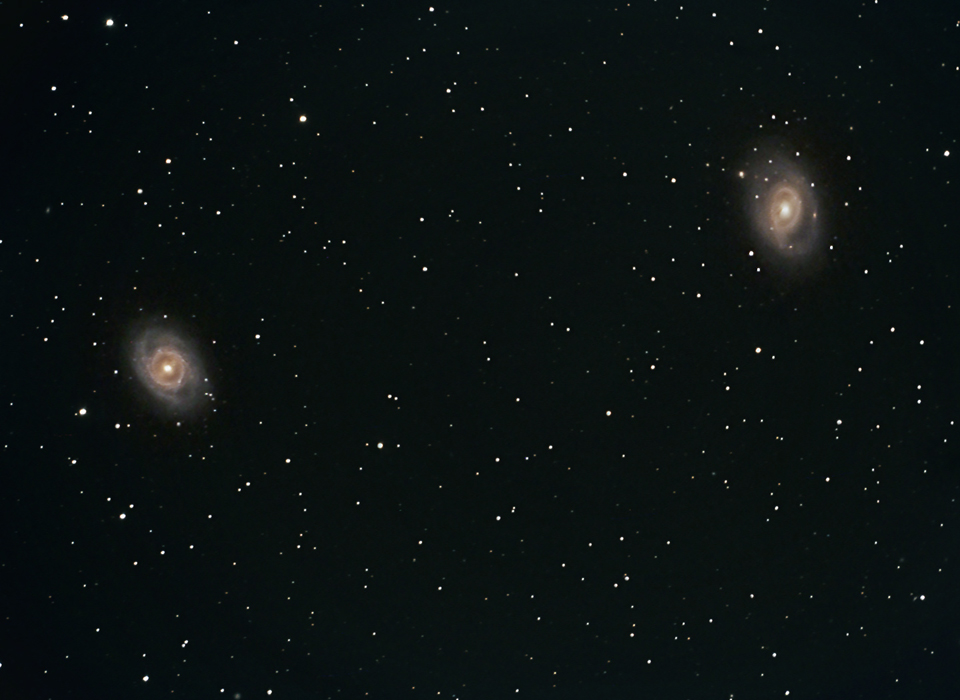 |
| (image: M95 (left) and M96 (right): Wikipedia) |
Messier 96 (M96, NGC 3368)
To be found just outside of the Leo Ring (see below), and the brightest galaxy of the M96 Group, M96 is a double-barred spiral galaxy with an off-centre (probably due to the gravitational pull of other galaxies) super-massive black hole at its core . We see it at a bit of an angle, so it looks slanted, and its spiral arms are irregular.
Messier 95 (M95, NGC 3351)
Near to M96 (31 million ly away) is another barred galaxy. In this image from Galaxy Evolution Explorer, the image on the left was taken in ultraviolet (necessarily taken in space as the Earth's atmosphere absorbs this electromagetic wavelength), and shows mostly the ring of star-formation around the core and in the spiral arms, because these are the 'higher energy' areas.
The visible image to the right shows more of the lower-energy parts of the galaxy, for instance the bars and core, where there is much interstellar gas and dust, warmed by the star-formation, or core, activity:
A
supernova (called
2012aw), marking the explosion at end of the star's hydrogen-burning life, was discovered by amateur astronomer Anthony Ayiomamitis in one of the arms of M95 in 2012:
Messier 105 (M105, NGC 3379)
M105 is not a spiral galaxy, but an elleptical galaxy, full of older stars with a very little star-formation (many elliptal galaxies have no recognisable new stars in the making), randomly orbiting the centre, which is a supermassive black hole (the size of several normal black holes together!). In this image from Wikipedia, you can clearly see what appears to be a dust ring spanning the galaxy:
I borrow two much magnified image of the area from
Two Old Guys Astrogear to show how, though we won't see them with our naked eyes, nor even with binoculars or a smaller telescope, there is a whole group of galaxies grouped together with M105 in what is called the
M105 Group:
and helpfully (just in case you'd like to investigate this group further) the author has named the stars (using
Wiki Sky)
[a couple of other Galaxies in this group are ellliptical galaxy
NGC 3384 (stars are a billion years old) and
NGC 3389 (part of the
M105 Trio) ]
The Ring of Leo (the Leo Ring)
The Leo Ring is a ring of interstellar matter surrounding the M105 Group of galaxies (rather than within them, as one might expect) but is as dense and clumpy as you might expect if it were within a galaxy!
The matter this ring is made of might be a hydrogen/helium gas remnant from the formation of the Universe, although that isn't proven. The only star formation that seems to happen in it are in tiny dwarf galaxies and is surprisingly devoid of the expected dark matter. It take the ring gas ring four billion years to slowly rotate (80km per second) once around the two central galaxies.
Wolf 359
Before we leave the area beneath the lion's belly, another celestial object worth mentioning is this red dwarf,
Wolf 359 [
Max Wolf catalogued many fast-moving stars], which, apart from the
Alpha Centuri system, and Barnard's Star, is the closest star to us at less than 10 ly!
Unfortunately, it's too faint to see except with a really strong telescope because, though close, it's very faint and cool. But it is interesting that water molecules have been detected using its spectrum, and that it has strong magnetic fields. Also, it's a pretty young star, and every now and then sends out bursts of high energy gamma rays. The most unusual thing about it, though, is how fast it moves against the background stars (its 'proper motion').
See its current position at the bottom of this image:
Lastly, because there is so many other celestial objects I could look at in the constellation of Leo, I'm going to pick just one more...because it's really pretty, and then leave you to investigate further if you wish to. The galaxy I chose is NGC 2903, on Leo's bottom jaw:
NGC 2903
This is, as I said, a pretty galaxy. It's a barred spiral galaxy a bit smaller than the Milky Way, either 20 or 30 million light years away (depending on the source), with a very high mix of both old and new star clusters in its centre.
Here it is in Astronomy Picture of the Day (APOD) rotated around:
and here's a close-up from another day on APOD, showing bright spots which, surprisingly, turn out to be young globular clusters, where the ones in the Milky Way are mostly clusters of old stars:
Oh, must mention these two galaxies as well: NGC 3607 and NGC 3502:
Gliese 436
I know there has been so much to look at in Leo, but before I go, right up on the border with
Ursa Major, the Greater Bear, and here marked with a small red circle (top left) is the position of the star
Gliese 436, around which are orbiting two known exoplanets - G
liese 436b (or
GJ 436b) and
Gliese 436c :
Of these, the one I want to say something about is the former, which, according to
Mark Turner, is a '
burning ice-cube'!
This little planet, the size of Neptune, is so densely packed in its
core that its gravitational pull doesn't allow the water to evaporate off the surface, even though the
planet orbits way closer than Mercury does to our sun (where
Gliese 436b orbits, it is a burning hot 440 degrees). And, even though its
sun has expanded into a giant, so that its surface area has cooled, you might think any water would have been completely evaporated by now! Find out more information on the planet at
Mach Principal.
The Leonid Meteor Shower:
Once a year, over a period of a few days around mid-November (about the 17th/18th), Earth passes through debris left behind by Comet Tempel-Tuttle, with 20 to 30 meteors an hour.
Every third of a century, the meteor storm hots up and there can be thousands of meteors an hour!
A couple more interesting things about Leo:
Leo is quite close to the constellation of the hunter, Orion, who holds up a lion's pelt. I wonder if the stories were once related as part of the same story.
The sun shone in Leo at the time of the flooding of the Nile, so the
Egyptians considered it a special constellation.
I found a few images of Leo that had the lion facing the other way:
but this was the only 3-D image I found of him:
Previous Constellation:
Ursa Minor



















